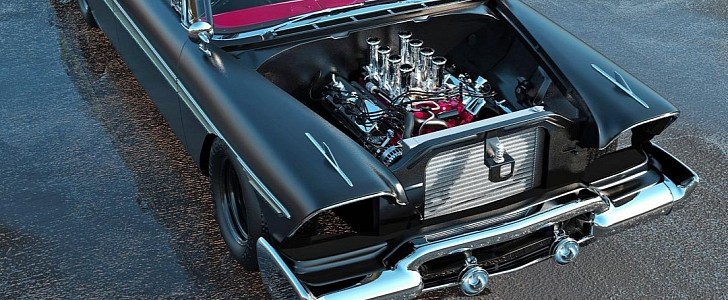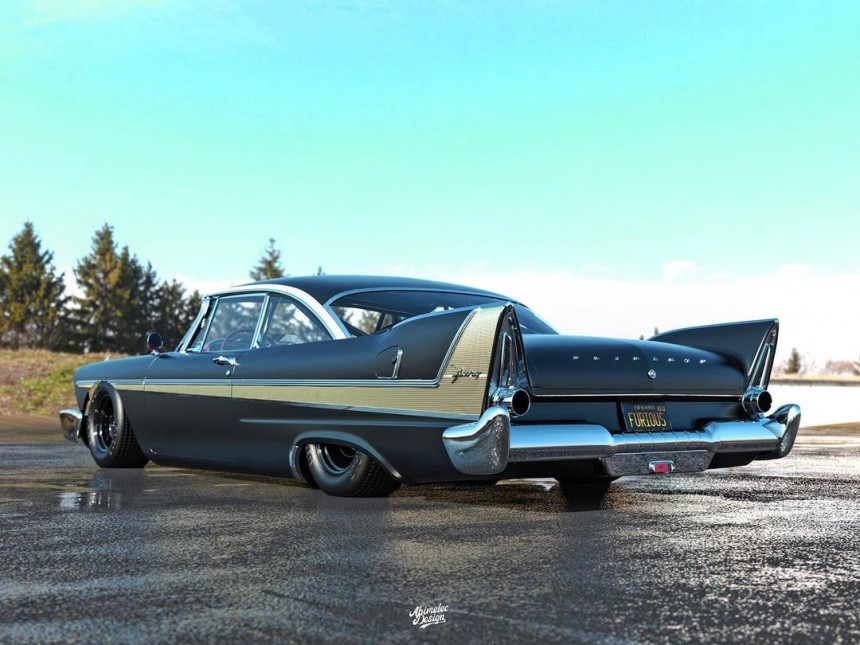Let's say you wish to take the original Plymouth Fury down the customization route. How do you approach such an icon, which set new standards for its brand and the entire automotive industry back in the day? Digital artist Abimelec Arellano answers the question with a rendering that brings a sophisticated mix of elements.
The Fury that started it all was a derivative of the Belvedere between 1956 and 1958, while its 1959 successor didn't just become a standalone model, but also replaced the Belvedere as the top dog of the now-retired carmaker. However, it was the original that brought the most styling innovations and arguably outshines all the models that came after it.
Design legend Virgil Exner is perhaps best known for the Forward Look he introduced on Chrysler cars starting from the mid-1950s, with his 1957 Fury arguably making for the most expressive design of the sort: mixing a low beltline with a generous greenhouse, the second model year of the vehicle was also one of the first to bring the front and rear decks at the same height as the fenders.
Then there was another signature styling move of the said designer, namely the rear fins. Together with the elements mentioned above, this made sure the Plymouth made for one of the most athletic appearances of the era.
The 1958 final hurrah, which is the topic of this transformation, was mostly set aside by its quad headlights, its tube grille, which came with a matching element below the bumper, and its smaller lollipop taillights - you can still enjoy the eye candy of the latter, but the said front bits are now gone, with the machine exhibiting an open face.
And if this approach gives you the chill, you should know it's supposed to. After all, as the artist explains in the first Instagram post below, this approach is an ode to John Carpenter's 1983 Christine horror movie, itself based on the eponymous novel Steven King released that year. However, the red finish of the '58 Fury starring in the motion picture was left behind for an even more dramatic take.
"The 'faceless' look inspiration came from a scene in the movie Christine, right when the car is all burned down sitting in the garage. The huge, forward-leaning hole in the front gives it a mean, staring look in my opinion, even if it doesn’t have headlights," Abimelec states.
Come to think of it, the digital build portrayed here does gift the Plymouth Fury with plenty of tech assets that might just be considered supernatural.
Not least due to being a scale-unfriendly, full-size offering, the Fury never enjoyed full motorsport attention back in the day. However, this digitally remastered version comes to challenge that by dropping the body on a NASCAR chassis.
And while the Plymouth never received HEMI motivation from the factory, making use of an otherwise respectable 350ci (5.7L) Golden Commando V8 churning out in excess of 300 hp, the engine bay is now occupied by a 426 HEMI, with the individual throttle bodies allowing the motor to properly express its mature voice.
The pixel master was diligent enough to add an extra layer to this proposal, introducing an additional visual treatment in the second Insta post below. This is inspired by the 3D efforts of Khyzyl Saleem, another artist whose work we constantly feature. After all, replacing the collectible gold-and-white look that set the original Fury apart with an all-black attire means this proposal now deserves extra attention - the newfound color scheme is the one that determined us to come up with the nickname in the title, while the creator chose to label the machine under "Furious".
Oh, and if the NASCAR approach seems familiar, it's probably thanks to the fact that Abimelec has used it in the past, as demonstrated by this otherwordly 1970 Dodge Super Bee.
Design legend Virgil Exner is perhaps best known for the Forward Look he introduced on Chrysler cars starting from the mid-1950s, with his 1957 Fury arguably making for the most expressive design of the sort: mixing a low beltline with a generous greenhouse, the second model year of the vehicle was also one of the first to bring the front and rear decks at the same height as the fenders.
Then there was another signature styling move of the said designer, namely the rear fins. Together with the elements mentioned above, this made sure the Plymouth made for one of the most athletic appearances of the era.
The 1958 final hurrah, which is the topic of this transformation, was mostly set aside by its quad headlights, its tube grille, which came with a matching element below the bumper, and its smaller lollipop taillights - you can still enjoy the eye candy of the latter, but the said front bits are now gone, with the machine exhibiting an open face.
And if this approach gives you the chill, you should know it's supposed to. After all, as the artist explains in the first Instagram post below, this approach is an ode to John Carpenter's 1983 Christine horror movie, itself based on the eponymous novel Steven King released that year. However, the red finish of the '58 Fury starring in the motion picture was left behind for an even more dramatic take.
"The 'faceless' look inspiration came from a scene in the movie Christine, right when the car is all burned down sitting in the garage. The huge, forward-leaning hole in the front gives it a mean, staring look in my opinion, even if it doesn’t have headlights," Abimelec states.
Not least due to being a scale-unfriendly, full-size offering, the Fury never enjoyed full motorsport attention back in the day. However, this digitally remastered version comes to challenge that by dropping the body on a NASCAR chassis.
And while the Plymouth never received HEMI motivation from the factory, making use of an otherwise respectable 350ci (5.7L) Golden Commando V8 churning out in excess of 300 hp, the engine bay is now occupied by a 426 HEMI, with the individual throttle bodies allowing the motor to properly express its mature voice.
The pixel master was diligent enough to add an extra layer to this proposal, introducing an additional visual treatment in the second Insta post below. This is inspired by the 3D efforts of Khyzyl Saleem, another artist whose work we constantly feature. After all, replacing the collectible gold-and-white look that set the original Fury apart with an all-black attire means this proposal now deserves extra attention - the newfound color scheme is the one that determined us to come up with the nickname in the title, while the creator chose to label the machine under "Furious".
Oh, and if the NASCAR approach seems familiar, it's probably thanks to the fact that Abimelec has used it in the past, as demonstrated by this otherwordly 1970 Dodge Super Bee.












